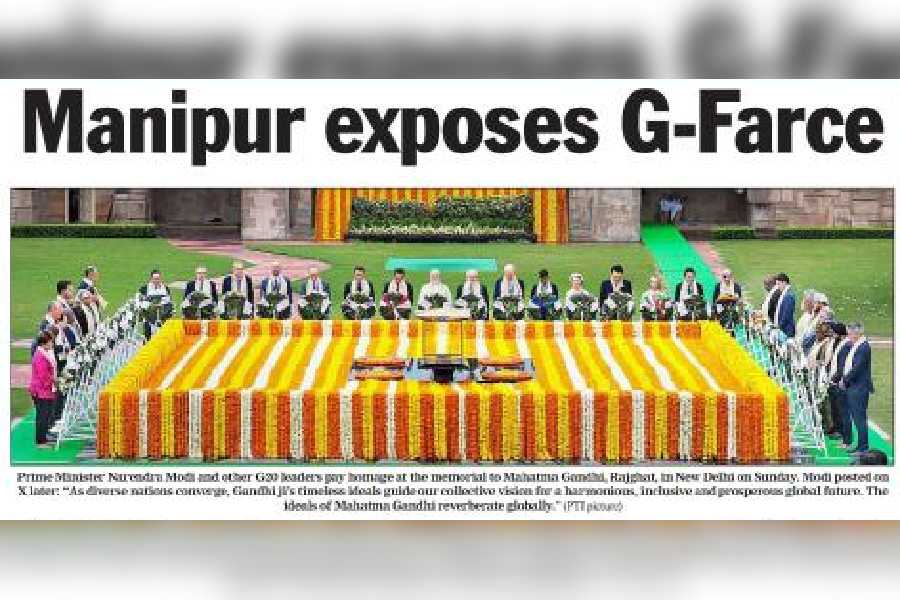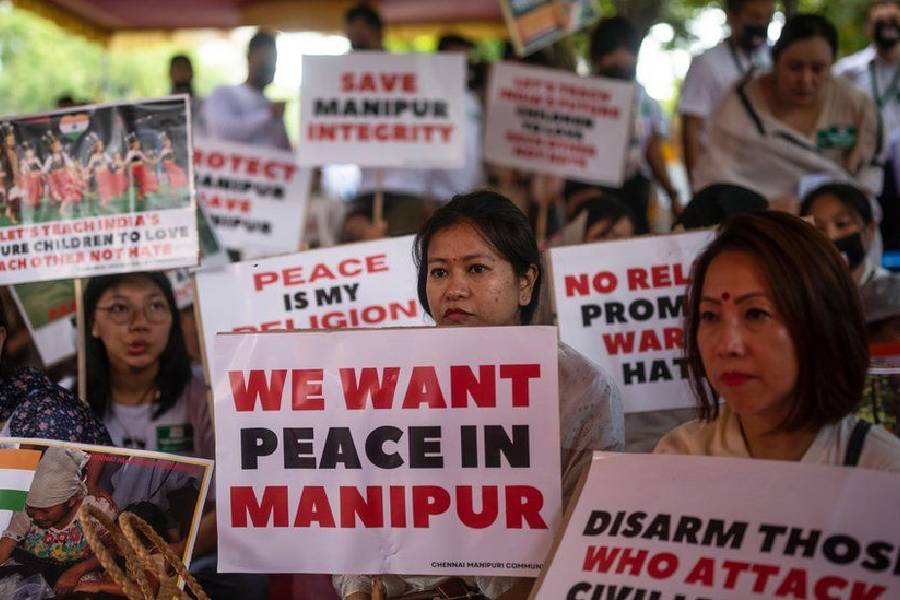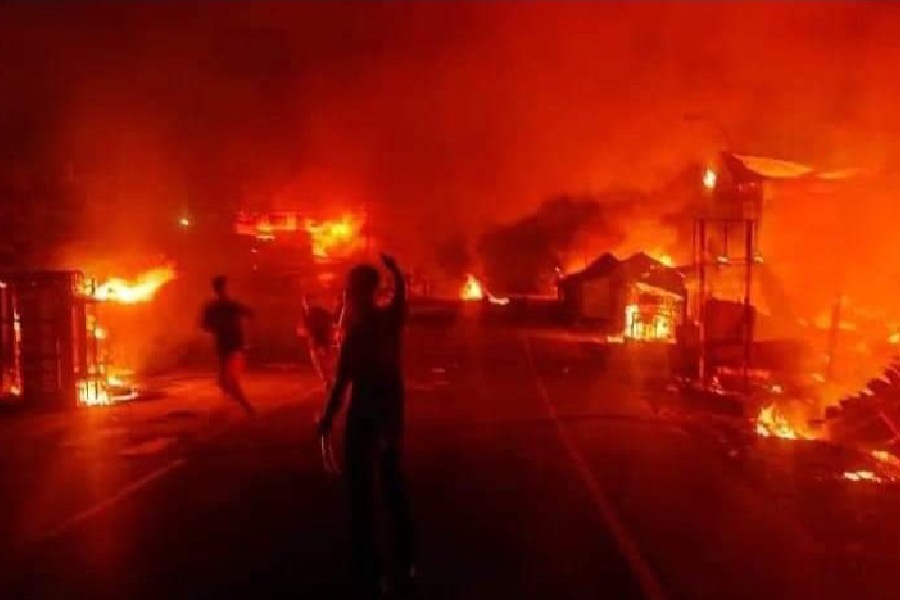Three people were gunned down in Manipur’s Kangpokpi district on Tuesday morning in a first-of-its-kind ambush that suggests an attempt by the attackers to penetrate the hills inhabited by the tribal Kuki-Zo communities.
The latest killings of the Kukis indicate that the conflict has slid into a phase that throws up a security quagmire as the political leadership at the Centre and the N. Biren Singh government in the state drags their feet on restoring normality.
One, the nine men who launched the attack were wearing Manipur police’s uniform, a source in one of the central security forces said.
Two, they sprayed bullets from automatic firearms on three tribal men while they were travelling in a Gypsy along a kachcha road. The nature of the attack and the speed with which it was carried out suggest the killers were trained in using automatic weapons, a security officer said, flagging this as a grave concern.
Three, the kachcha road was built recently by villagers for safe access to the district headquarters, Kangpokpi, bypassing Imphal, a Meitei stronghold.
Four, a source said the attack was reminiscent of “war-like tactics” meant to discourage the use of the road. Other sources in Manipur said that the attack on Tuesday morning also indicated a “planned attempt” by the Meitei community to cut off the supplies and access to the hills by organising the attack on the kachcha road — built after seeking permission from the authorities of the Naga-dominated Ireng Naga village, through which it runs — and to create a “fear psychosis”.

The murders took place at least 3km inside the hills. That a safe zone could be breached suggests suspected Meitei extremists are feeling emboldened to cross over unchallenged by the security apparatus, carry out attacks and return. The buffer zone was created after the visit of Union home minister Amit Shah in May to minimise the possibility of conflict.
“The firing lasted less than a minute and all the three were killed on the spot.... The nature of the ambush, in which people on a moving vehicle were fired at and killed, confirms the involvement of trained Meitei militia, raised under the patronage of powerful figures,” said the source.
The three victims — all residents of Ponlen Kuki village in Kangpokpi district — were identified as Ngamminlun Kipgen, 32, who was suffering from high fever and was taken to the district headquarters for medical attention by the two others, Satneo Tuboi, 37, and Ngamminlun Lhouvum, 30.
After Tuesday’s incident — close on the heels of another strike on Kuki-dominated Pallel in Tengnoupal district on September 8 in which three people were killed —
the death toll in Manipur since May 3 has crossed 180.
“The armed men could not have reached the Kuki-Zo-inhabited village without the complicity of the police as they had to first cross a buffer zone, guarded by central forces and Manipur police in some patches, and then a Naga village (Ireng) to reach the area. After carrying out the operation, they returned to the Imphal valley through the same route,” said a source in the central forces.
“After the incident, several people of Ireng village told the Assam Rifles and police teams that visited the area that they saw armed men in police uniform running down claiming that they had killed three Kukis.... The group then escaped to Kadangband, a Meitei-dominated area,” said the source.
In a memorandum submitted to President Droupadi Murmu on Tuesday, the Zomi Council Steering Committee, representing nine Kuki-Zo tribes of Manipur, cited Tuesday morning’s incident and demanded a physical verification of all Manipur police commandos and personnel to identify the armed Meitei militia — known as Arambai Tenggol and Meitei Leepun — in the force. The forum suggested that the services of the force be “temporarily disbanded” till the violence fully subsides.
The main concern of the Kuki-Zo community after Tuesday’s incident is the ease with which the armed Meitei group breached the buffer zone.
“Till now, the Kukis faced attacks in the valley and on the foothills.... It seems now the Meitei community has targeted the hills. The signs are ominous at a time the Manipur government is trying to demean the role of the central forces,” said a source.
The Manipur cabinet, during a meeting on Saturday chaired by the chief minister, condemned the “unwanted actions” of central security forces on civilians during the Pallel incident, besides resolving to apprise the Centre of the incident.
The Zomi Council has already demanded that only central paramilitary forces be deployed in the buffer zones to minimise the possibility of the Meitei militia sneaking into Kuki-dominated zones. In its memorandum, the council has iterated its demand for a separate administrative set-up for the hill areas, inhabited by the tribal communities.
“No concrete action was taken after the Pallel incident.... The cabinet condemned the action of the central forces, especially the Assam Rifles, but didn’t say anything about the attack by the Meitei community on the Kukis. This silence is the main reason behind the continuation of the strife,” said a source.
“This kachcha road is the only route available for the supply of essentials.... It is also the only communication link, bypassing Imphal, between the Kuki-dominated Churachandpur in the south and Kangpokpi in the north. This road link was made with donations from local people after Imphal became inaccessible.... Those coming to the Kuki areas from outside, like Guwahati and Dimapur, have also been using this road,” said another source in the security establishment.
“After this ambush, people will think twice before using the route.... These are tactics adopted during wars. The sad part is neither the state nor the central government is doing anything to bring an end to this situation,” added the source.
The solution to the problem, an armed force official said, lies only in firm action by the central paramilitary forces.
“The matters cannot change unless the central forces are allowed to dominate the vulnerable areas.... They have access to technology like drones and they are there for four months, which means they know the trouble-torn areas. They need to be given instructions from the top, but it seems that’s not happening,” said the officer.












